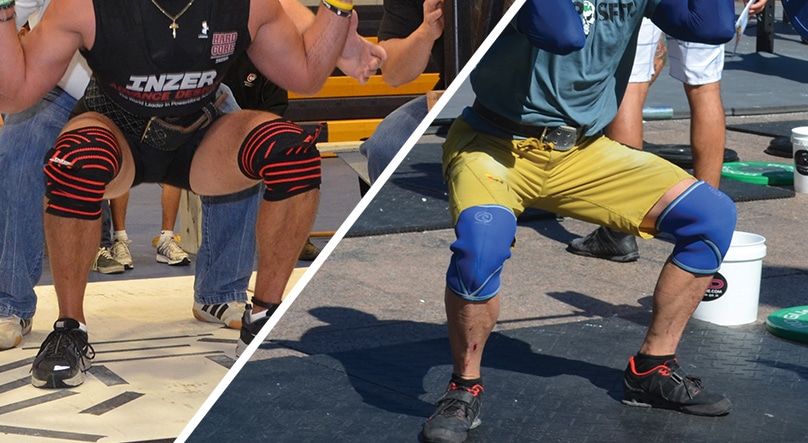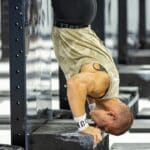Knee wraps and knee sleeves—no, they are not the same thing. Surprised to hear that? Knee wraps and knee sleeves each have their unique advantages and disadvantages. So, what do wraps and straps actually do? Here’s a breakdown of knew sleeves vs. knee wraps.
Jump to:
What are knee wraps?
Commonly worn by competitive powerlifters and bodybuilders, knee wraps are made of the same elastic material that is typically found in wrist wraps. They are designed to be wrapped around the knee in a spiral or diagonal method for use in squats.
Advantages
The reason knee wraps are so highly valued by powerlifters is that they allow more weight to be lifted in the squat. How? During the eccentric (downwards) phase of the squat, the tightness of the wraps allow for a high amount of elastic energy to be stored, which can subsequently be released during the concentric (upwards) phase—resulting in heavier and faster squats.
Furthermore, knee wraps are believed to reduce stress and pulling forces on the quadricep tendon, which is attached to the quadriceps and the patella (the kneecap). When you squat, the tendon pulls on the patella. Reducing the stress on the tendon helps to avoid detaching your tendon from the patella, or tearing your quads altogether, which are both pretty nasty injuries. When you consider the monster weights that competitive powerlifters move in the squat, it makes sense why powerlifters choose to squat with knee wraps.
Disadvantages
While knee wraps do allow you to move more weight, they don’t necessarily help you get any stronger. This is because they are restrictive in nature, and because they completely cover the patella and are worn tightly (thus pushing the kneecap into the thighbone), they can increase the friction between the patella and the cartilage of the kneecap. As you might expect, this can lead to injury and troublesome knee joint problems like arthritis.
In fact, a 2012 study published in the Journal of Strength and Conditioning Research examined the impact of wearing of knee wraps on mechanical output and performance characteristics of the back squat. In the study, ten “resistance-trained men” performed 6 single back squats at 80% of their 1 rep max—3 reps wearing knee wraps, 3 without them. The researchers found that wearing knee wraps provided a 39% reduction in horizontal barbell displacement—when you squat, the barbell doesn’t solely travel in a vertical plane (up and down), it also moves horizontally (backwards and forwards). You want to have a low horizontal barbell displacement when squatting to increase efficiency. When the lifters performed the eccentric portion of the lift wearing knee wraps, they performed it 45% faster than when they were unwrapped (likely due to the storage and use of elastic energy in the knee wrap). Finally, “mechanical work involved in vertically displacing the center of mass was performed 20% faster and was reflected by a 10% increase in peak power.”
From their findings, the researchers concluded that the reduction in horizontal movement—though helping to increase mechanical output—actually altered the technique of the lifters, changing the muscles targeted by the exercise and increasing friction in the knee joint.
What are knee sleeves?
There’s a good chance that at least one athlete at your box is sporting a pair of knee sleeves during squat or OLY lifting work. Knee sleeves are compressive…well…sleeves that you slide over your knees, and are typically made of a neoprene material.
Advantages
The primary purpose of knee sleeves is to protect the knees from future injury or risk of damage. They are NOT knee braces, which are built to protect a previous injury in the knee from further ailments. Right off the bat, this is an important distinction to make. Knee sleeves are not intended to be worn to fix an already damaged or unstable knee.
However what sleeves do provide is valuable compression, which helps to increase blood flow and reduces pain and swelling in the knee joint during and after a workout. This will ultimately help you to recover quicker—thus allowing you to perform better on a day-to-day basis.
While knee sleeves do add warmth and compression, they also help the mechanics of a given movement by limiting patella movement, provide lateral stability and can increase your proprioception (the sense of the relative position of neighbouring parts of the body—in this case the knee joints—and strength of effort being employed in movement).
Disadvantages
Depending on the type of knee sleeve you buy, they can be a little pricey, and tend to get a little stinky if you don’t wash them regularly. Furthermore, people make the mistake of assuming that wearing knee sleeves will automatically improve their technique and makes them a better lifter. This is false. You still need to be diligent with regards to your mobility, refining the mechanics of your lifts and taking care of the knee joint (and your body) as best you can. When you start to move heavy weight in high volume, then it’s time to slap on the sleeves to help protect your knees from the stresses and strains that cleans, snatches and squats provide.
Conclusion?
Ultimately, the type of knee accessory you choose to wear will come down to your particular fitness goals and concerns over the health of your knees. There’s a reason knee wraps are preffered by powerlifters, as their goal in competition is to move as much a weight as possible. However, knee wraps are much more restrictive than knee sleeves, making them almost impossible to WOD in. Knee sleeves are more commonly used in the CrossFit community, given their versatility and the fact that they help athletes to recover from heavy lifting sessions. However, if you do decide to go with sleeves, don’t rely on them too much and fall away from working on your mobility and technique.














